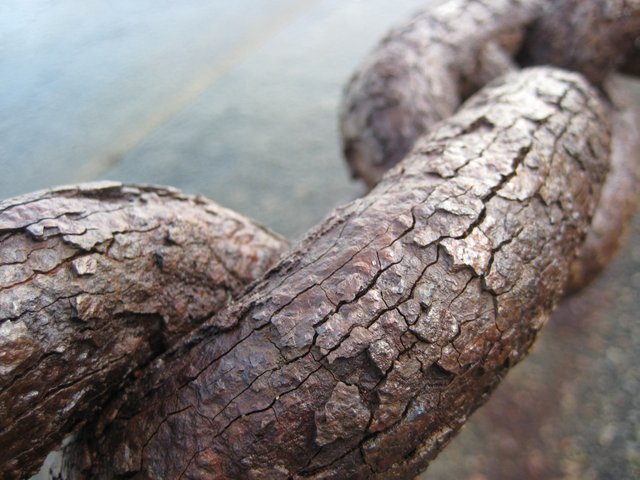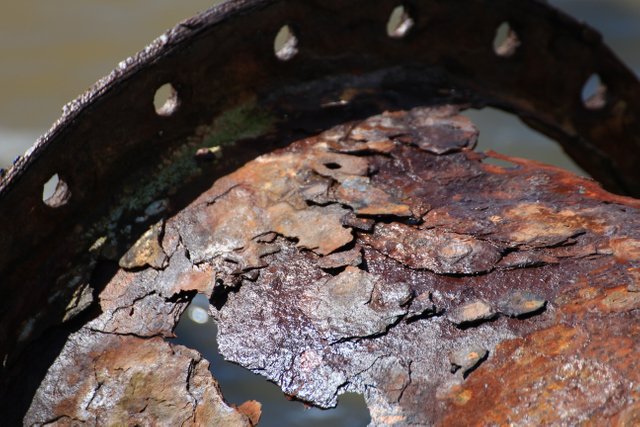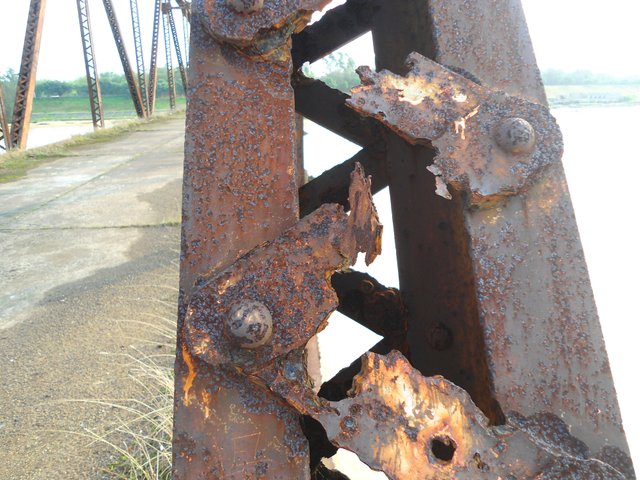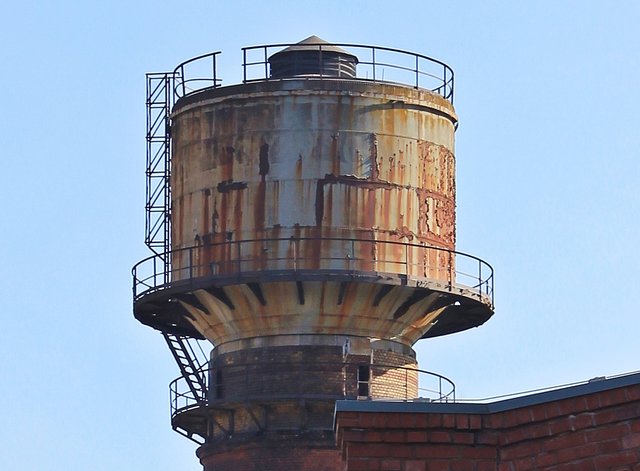Corrosion Engineering: Introduction and Cost Implications of Corrosion (Part 1)
Hello steemians, it is nice to be writing again and I hope you have been gaining a lot on this blog.
Today, I have decided to write about an aspect related to materials engineering. We will be looking at corrosion and its adverse effects.
INTRODUCTION
Permit me to start on a lighter note.
It has been close two years since I completed my first industrial training. If you had read my article on Automobile lubrication system, I wouldn’t need to repeat that I had my training in an automotive maintenance company. I never wanted to have it there, but as fate will have it, I ended up there.
I had a good time and a successful training, although it was really stressful working there (what I was really running from). You don’t sit while trying to repair a car. Even when you lie on a creeper (I am not physically challenged, I am talking about a board with wheels used while working under the car) your hands are still always suspended above your head trying to fix one component or the other.
My boss was a disciplinarian. He likes his orders to be followed strictly and really believed so much in his capabilities. Well, I wouldn’t take that as pride, but maybe you do. Perhaps when you work with him for six months and realize that he is really a guru in fixing cars and vast in technology you will change your mind. I must tell you, I have only seen few people like him. He really know what he’s is doing and for that I respect and like him.
When I completed my training and returned to school for my final year, we spoke for few months and I never really called him again. Well, now I’m done. He really played a significant role in my life so I decided to pay a visit to his workshop earlier yesterday. I had initially planned to go this morning. However, going today would have been probably impossible as the President is visiting Lagos today and the roads will be busy. So it was essential I made the trip yesterday.
He (my boss) seemed happy to see me, but as usual there’s work on ground. Fortunately for me, he had just completed the repair of a car (Nissan Pathfinder) - meaning I wouldn't have to do much. He had replaced the transmission shift solenoid (just forget about that) and It was time for test driving. Perfect, I was just in time.
I hopped into the car with joy and drove off for the test. I was really accelerating high to test the shift response of the transmission and yes, it was responding correctly. I do feel intoxicated when driving and you would think I just hijacked the car, but what I didn’t know was that my high spirit was getting close to an end.
Out of nowhere, I ran the car into a pot hole and like any one would do, even though the deed is done, I had to still brake. However, it was too late. A strange sound coming from the right front end even made me brake completely. I got down to check. Damn! - The lower control arm on that end had torn out from the chassis. How could that be?
Running into a pot hole shouldn’t have resulted in such damage. I was already sweating, for the cost that will be incurred is not little. The fact that the car can’t be moved anymore (cos the state of the car is like a man with a broken leg) and it’s just few inches from the pot-hole made me panic more. It’s obvious I ran fast into the pot-hole. Who is gonna pay for this? Not that my boss will have me pay for it though, but I have caused him some losses. He will have to bear the cost. Oh God – I hate myself for this.
I kept asking questions about what could have caused such damage. I had to take a closer look. Then I found something – Yes! I knew it wasn’t my fault. That impact couldn’t have caused this. I discovered that the chassis of the car had corroded beyond control. Even my hand could peel and pull out some layers of metal. Although if I was careful, it shouldn’t have happened with me. Well, at least I have something to blame, but it still doesn’t take the responsibility off my boss.
Eventually, we repaired the car just to deliver it to the owner and my boss had to pay for the repair. But can you blame me for that? Please don’t. It was the effect of Corrosion. Sooner or later what happened with me would have happened to whoever was driving the car and the owner would have spent some cash to fix it.
In fact, as it stands, if he hasn’t disposed that car yet, he will still be spending on it. A car without a chassis (well rusty chassis if you like) is like no car, cos the chassis is what the car rests upon. Even the next damage could be worse and life threatening, if it doesn’t even take life.
Well, that was my ordeal with corrosion. It wasn’t the kinda reunion I envisaged, but my boss was understanding at the end. For that, I felt relieved.
Corrosion is an uninvited guest which you just have to entertain, but you could delay its arrival (although, sooner or later it will arrived) by proper practices as well as minimize the inevitable cost. On this note, I say let's go into the discussion proper.
DEFINITION
I wouldn’t want to bore you with the theories behind corrosion, cos for this article it is not necessary. I believe we are all familiar with corrosion. The most common is the corrosion of ferrous (iron-containing) metals, which we all know as rust. You will agree with me that rust has cost us some precious belongings. Even beyond our homes rust and corrosion has done a lot of harm to infrastructures. Having said these, I will say again that there’s no need to go into the theories as they are not vital to the current discussion.
However, I will give a definition.
Even with you just thinking about the various ways in which you might have encountered corrosion, I believe you should be able to define it in your own words. Nonetheless, I will save you that stress and add some things you might not even know.
Corrosion is a process (chemical, electrochemical or mechanical) that results in the depletion or deterioration of a material as a result of the interaction of such material with its environment.
I remember one of my visits to Ibadan as a child, I saw many brown roofs. If you take a picture in that region, from the top, you will hardly see a bright-colour roof. Those roofs were made of iron and their brown colour is as a result of rust. Some other cases of rust can be found within our homes.
It is of general belief that only metals corrode. However, let me tell you this – non-metals corrode as well; surprised?
Although most non-metallic (such as ceramics, polymers, glass and so on) materials are resistant to corrosion, under certain conditions corrosion can be observed in them. Glass for instance corrodes in the presence of superheated water. A comprehensive detail of the mechanism of glass corrosion can be found here. Now, let’s move on.
CORROSION ENGINEERING
The field of engineering is one which has revolutionize our world. It is in fact an understatement so say that we owe a lot to the field of engineering. Every product ranging from consumer goods, to medical equipment, various utilities transportation and so on are all the works of engineering. Engineering has evolved in recent years and has given birth to many branches. Corrosion engineering is one of such although this is not a recent field.
Acccording to Mars Fontana:
Corrosion engineering is that which is concerned with the application of science and art in a bid to prevent and control corrosion damages in an economical and safe manner. (Paraphrased by me).
It is essential that corrosion engineers are vast in the practice and knowledge of corrosion so as to be capable of combating the adverse effects of corrosion.
CORROSIVE ENVIRONMENTS
Any environment can be corrosive. It all depends on the nature of the material in question. For instance, it is general believe that stainless steel is always corrosion–resistant. Well that’s not completely wrong and this is why it is mostly used in food processing industries due to the stringent quality requirement of food products as well as in making medical equipment. However, you should know that “Lord” stainless steel is not stainless. Under certain conditions, such as in a chloride environment, stainless steel will corrode.
Hence the environment wherein a material is, decides its corrosion behavior. Example of corrosive environment are - Acids (inorganic or organic) such as Hydrochloric acids, sulfuric acid, acetic acid; Air and Moisture; Soils; Alkalines; and so on.
Another point worth noting is that Temperature and Pressure are agents of corrosion. The presence of high temperature and pressure coupled with a corrosive environment, makes a material very susceptible to corrosion and increases the corrosion rate.
CORROSION EXPENSES
The term the “expenses of corrosion” in this context refers to all the losses associated with corrosion. Corrosion expenses represents a huge loss in the economy of a country. According to the study by the National Association of Corrosion Engineers (NACE), the Global cost of corrosion in 2016 was $2.5 trillion which is about 3.4% of the global Gross Domestic Product. It was also revealed that the amount spent by the US annually to combat all natural disaster such as tornedo, flood, hurricane etc. is far less than that spent on corrosion.
These losses represents an aggregate from a lot of industrial sectors which includes – Transportation, Production and Manufacturing, Utilities, Infrastructure and so on. This cost of corrosion could be direct or indirect. Direct cost are those incurred from the prevention, maintenance, replacement of failed equipment and corrosion monitoring and inspection.
Indirect costs includes low productivity as a result of faulty or underperforming equipment; Shutdown losses as a result of discontinued production due to breakdown from corrosion and so on.
The prevention of corrosion requires the implementation of some methods. The most common to us is the coating or simply painting of the material. Some equipment will require maintenance regularly to avoid their breakdown while some will require complete replacement.
Most times, to implement optimum maintenance strategies, proper and continuous inspection and check are required to monitor the integrity of equipment. An example is the Hydrostatic testing (a type of non-destructive testing) of a pressure vessel holding a corrosive substance such as a steam drum.
The corrosion of metal bridges is one example which we can use to view the concept of direct and indirect costs of corrosion. The bridge will require maintenance and thus, the concerned institution will incur some cost i.e. direct cost.
Imagine what will happen if a bridge such as third mainland bridge in Lagos linking people with their place of commercial activities is closed. That is where the indirect cost comes in. People who ply such road will have to find other route which may be longer and will result in delay, more fuel consumption, lateness to work and so on.
In the case of water distribution system, corrosion often results in pipe leakages which results in the shortage of water supply to the end-users. On the side of the supplier it is a production loss and often calls for a repair which might be the replacement of a portion of the pipeline.
We all know that no company wants to stop producing its product. A stoppage in production implies loss in production and thus revenue. In some cases when a machine vital to production breakdowns, it is essential to keep some other equipment running.
Let me give an example. I had a training in a power plant firm during my first industrial training. When we have a major breakdown such as a tube leakage in the steam boiler of a generating unit, we have to shut-down some other equipment and keep some (almost all the auxiliaries) running. These auxiliaries will be ran like they would under normal electricity production.
For instance, we have most oil pumps running to ensure the continuous lubrication of the bearings of the steam turbine. The turbine though has been shut-down, but its shaft must be kept in rotation at a very low speed (an operation know as barring) to prevent its sagging. What I'm saying here is that, aside deferment, there are losses associated with running some equipment during shutdown as there is no production to just their use. It is like doing what you should be paid for, for free. However, you have to, to prevent more havoc.
The cost associated with corrosion losses, from the outlook of what a company could have generated in terms of revenue is best seen in the oil industry. A survey carried out on an onshore oil company, OML 124, in the south-eastern part of Nigeria showed that in 2008, of the total cost of corrosion, deferment (lack of production) had a portion of 64 %, with maintenance, prevention and inspection and monitoring taking the remainder. This was obtained by multiply the cost per barrel of crude oil with the number of barrels that could have been produced during production downtime.
Corrosion is like a parasite. It sucks really hard into the funds of an industry. Although it is inevitable, it can be minimized and so is the cost, by implementing the best engineering practices.
CONCLUSION
I initially intended to finish this article at once. However, I will like you to digest the above as if I go further, you could get bored and tired. So let me leave you with this for now. Next time, I am going to post the remaining portion.
.
Although the greatest adverse effect of corrosion is the monetary losses. Nonetheless, you should know that the cost of corrosion are not only monetary. I will like to bring to your attention some of the other adverse effects of corrosion and finally we will also look at some techniques to prevent corrosion.
Thanks for reading through. I look forward to having you here again.
REFERENCES
- Mars, G. F. (1987). Corrosion Engineering (Third Edition). McGraw-Hill Book Company.
- Akinyemi O. O., Nwaokocha C. N., and Adesanya A. O. (2012). Evaluation of Corrosion Cost of Crude Oil Processing i
Industry. Journal of Engineering Science and Technology, Vol. 7, No. 4 (2012) 517 - 528. - Fong, Y. M. (2012). Corrosive Effects of Chlorides on Metals, Pitting Corrosion, Prof. Nasr Bensalah (Ed.), ISBN: 978-953-51-0275-5, InTech.
- Gerhardus, H. K., Michiel, P.H., Brongers, Neil, G. T., VIRMANI, Y. P. and Payer J. H. Corrosion Costs and Preventive Strategies in the United States. National Association of Corrosion Engineers. Publication No. FHWA-RD-01-156
- NACE study estimates global cost of corrosion at $2.5 trillion annually
- Corrosion of non-metallic materials (Part-2)

If you write science, technology, engineering or mathematics, please feel free to join the steemSTEM community on discord and join the conversation here






Nice post thanks for sharing
Good post. Today I found a piece of metal in the parking lot at work. It looked like it was part of the coil spring of a car. Corroded at both ends and sitting on the ground in a carpool spot. I really hope it didn't just get driven away in that condition with many people in it...
Well I hope so too. Driving with faulty parts could be disastrous especially when dealing with rust.
Thanks for your contribution.
I like the entertaining style, very easy to read. My wife and I were talking the other day about whether any evidence of humans would be left after a million years ( if we all died tomorrow!). What material could survive that long?
The longevity of any material depends on its application and nature. Generally we cannot say a particular material will last long. However more stable metals like gold would last longer due to their inert nature.
My wedding ring might survive. Thanks for the answer
You'd make a great teacher, the way you pass across knowledge is so effortless.
Corrosion is a very important topic, I hope your next post talks about corrosion inhibitors.
Yh... I will discuss the protection of materials from corrosion including the use of inhibitors.
Thanks for dropping by.
Corrosion is a very wonderful engineering aspect.. The money spent on corrosion is quite expensive. Especially when one little component corrodes and you can easily get that component part.
Corrosion is indeed is a parasite. It requires great attention otherwise you will be losing more that you imagine.
Yes i remember one of my lecturers in school said something similar. Great article sir.
Long article :P
I enjoyed the story and the description and I think that by following some of the pointers I already gave you, it could be more concise, without losing your personal style.
Also don't be afraid to better yourself by learning about the chemical process of oxidation and corrosion. At the end of the day it will help you be better in your work.
Cheers!
Well not that I'm not aware of the chemical processes on corrosion. It's just that I am discussing the cost implications instead.
Maybe on the next one you can share the knowledge with the others. Many people will want to learn, myself included. Even if I know the processes, reading a new article or even skimming it makes the brain remember the concepts and keeps the cognitive process fresh. You can even postpone Alzheimer's through keeping your brain active.